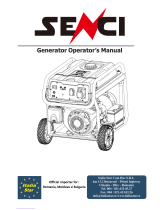
41135
6800 Starting Watts / 5500 Rated Watts
PORTABLE GENERATOR
TABLE OF CONTENTS
Introduction ............................. 1
Introduction ........................... 1
Portable Power Generator .................. 1
Accessories ........................... 1
This Booklet ........................... 1
Manual Conventions. . . . . . . . . . . . . . . . . . . . . . . . 2
Safety Rules ............................. 3
Controls and Features ...................... 5
Generator ............................. 5
Power Panel ........................... 6
Parts Included ......................... 7
Wheel Kit .......................... 7
Other ............................. 7
Assembly ............................... 8
Remove the Generator from the Shipping Carton .. 8
Install the Wheel Kit ..................... 8
Install the Support Leg ................... 8
Add Engine Oil ......................... 8
Add Fuel ............................. 9
Grounding ............................ 9
Operation .............................. 10
Generator Location ..................... 10
Grounding ........................... 10
Surge Protection ....................... 10
Starting the Engine ..................... 10
Connecting Electrical Loads ............... 11
Stopping the Engine .................... 11
Do Not Overload Generator ................ 11
Capacity .......................... 11
Power Management ................... 11
Wattage Reference Chart ................. 12
Operation at High Altitude ............... 12
Maintenance and Storage ................... 13
Engine Maintenance .................... 13
Oil .............................. 13
Spark Plugs ........................ 13
Air Filter .......................... 13
Spark Arrester ...................... 14
Cleaning .......................... 14
Adjustments ........................ 14
Maintenance Schedule ................ 14
Generator Maintenance .................. 15
Storage ............................. 15
Generator Storage .................... 15
Specifications ........................... 16
Engine Specifications ................... 16
Generator Specifications ................. 18
Fuel ............................... 16
Oil ................................ 16
Spark Plugs .......................... 16
Valve Clearance ....................... 16
Parts Diagram ........................ 17
Parts List ............................ 18
Engine Parts Diagram ................... 19
Engine Parts List ...................... 20
Wiring Diagram ........................ 21
Troubleshooting. . . . . . . . . . . . . . . . . . . . . . . . . . 22
Warranty .............................. 23
Warranty Qualifications .................. 23
Repair/Replacement Warranty .............. 23
Do Not Return The Unit To
The Place Of Purchase .................. 23
Warranty Exclusions .................... 23
Normal Wear ....................... 23
Installation, Use and Maintenance ........ 23
Other Exclusions ..................... 23
Limits of Implied Warranty
and Consequential Damage ............. 23
Contact Information. . . . . . . . . . . . . . . . . . . . . 23
Address ........................... 23
Customer Service .................... 23
Technical Service .................... 23
































